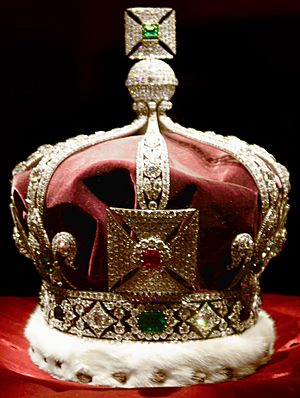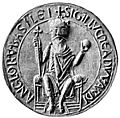Crown Jewels of the United Kingdom facts for kids
The Crown Jewels are a special collection of valuable items used by the kings and queens of the United Kingdom. They are worn during important events like the coronation ceremony, where a new monarch is officially crowned.
This amazing collection includes many different objects:
- Crowns: The most famous items.
- Sceptres: Rods held by the monarch, often with a cross or a dove on top.
- Orbs: Golden balls topped with a cross, showing the monarch's power.
- Swords: Used in the ceremony as symbols of justice and protection.
- Rings: Representing the monarch's commitment to the nation.
- Spurs: Golden spurs, linked to knighthood.
- Royal robes: Special clothes worn during the ceremony.
Many of these jewels have a long history, going back hundreds of years. They also have a religious meaning, as they are used in a sacred ceremony.
Contents
The English Civil War and the Jewels
After King James I died, his son Charles I became king. Charles I believed that kings were chosen by God to rule, which led to many disagreements with Parliament. These arguments, along with religious conflicts, started the English Civil War.
After six years of fighting, King Charles I was defeated and executed by Parliament. Oliver Cromwell then became the leader of England, known as the Lord Protector. Less than a week after the king's death, the monarchy was abolished.
The new English Republic needed money badly after the war. So, a law was passed to sell the king's personal belongings, including the Crown Jewels. People were chosen to value the jewels and sell them to the highest bidder. The most valuable item was the Tudor State Crown, which was worth £1,100 (about £1.7 million in today's money). It was decorated with 28 diamonds, 19 sapphires, 37 rubies, and 168 pearls.
Amazing Crowns of the Collection
The Crown Jewels collection has many different crowns. Some are used by every new monarch, while others were made for specific kings, queens, or their partners (consorts). Crowns made for kings usually have a slightly pointed top, while those for queens have a slightly bowed top.
- St Edward's Crown was made in 1661. It is very heavy, and some monarchs find it hard to wear during the coronation.
- The Imperial State Crown was made in 1937 for King George VI. It looks similar to a diamond crown made for Queen Victoria in 1838.
- The Imperial Crown of India was made when King George V visited Delhi to be crowned Emperor of India. British law said that Crown Jewels could not leave the country, so a new crown had to be made for this trip. It has not been used since and is stored with the other Crown Jewels, but it is not officially part of the British Crown Jewels.
- The George IV State Diadem was made in 1820 for King George IV. It was worn by Queen Victoria and Queen Elizabeth II during their coronation parades.
- For a long time, queens consort (the wives of kings) wore the crown of Mary of Modena, who was the wife of King James II. But by the early 1900s, this crown was very old and worn out.
- A new crown was made for Queen Alexandra, wife of King Edward VII. This crown had a flatter, more European style.
- Later, a crown more like the traditional British style was made for Queen Mary, wife of King George V, for their coronation in 1911.
- The last new consort's crown in the 20th century was made for Queen Elizabeth, wife of King George VI. Their coronation was in 1937. All three of these queens' crowns featured the famous Koh-i-Noor diamond.
- The Crown of the Queen Mother is a special platinum crown made for Queen Elizabeth, the mother of Queen Elizabeth II. She wore it at her coronation in 1937. It was the first British consort's crown made of platinum. This crown was crafted by Garrard & Co, a company that has made many British royal crowns.
The crown is decorated with many precious stones. The most famous is the 105-carat Koh-i-Noor diamond, which is in the middle of the front cross.
The Famous Koh-i-Noor Diamond
The Koh-i-Noor diamond was given to the East India Company in 1849 by the former rulers of Punjab. It became part of the British Crown Jewels when Queen Victoria was declared Empress of India in 1877.
The crown also holds the Lahore Diamond (22.48 carats), which was given to Queen Victoria by the East India Company in 1851. Another 17-carat diamond was given to Queen Victoria by the Sultan of the Ottoman Empire in 1856.
Today, the Crown of the Queen Mother, along with the other British Crown Jewels, is on display at the Tower of London.
Images for kids
-
King Æthelstan presenting an illuminated manuscript to St Cuthbert, around 930.
-
The Stone of Scone inside the Coronation Chair, 1859.
-
Elizabeth I in her coronation robes, around 1600.
-
Charles I standing next to Henry VIII's Crown, 1631.
-
Thomas Blood trying to escape with the jewels, drawn in 1793.
-
The Imperial State Crown.
-
Coronet of Prince Frederick.
-
Trumpeters and a mace bearer at the 1685 coronation of James II.
-
Altar dishes behind George V in 1911.
-
The Lily Font on top of the Charles II font and basin at the christening of Edward, Prince of Wales, 1842.
See also
 In Spanish: Joyas de la Corona británica para niños
In Spanish: Joyas de la Corona británica para niños






















